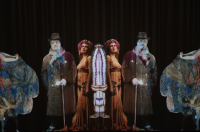Must-see:
-
Don Quixote
The Don Quixote ballet has little to do with the hidalgo himself; rather, it’s inspired by a sole episode from Miguel de Cervantes' best-selling novel of the same name that tells the story of two star-crossed lovers who prove that love always wins. The original production was created by Marius Petipa to the music of Ludwig Minkus and debuted in 1869 at the Bolshoi Theatre in Moscow. These days, the ballet is inspired by its early 20th-century versions – and still well-loved for its Spanish flair, national costumes and dances, and festive, feel-good atmosphere.
-
Swan Lake
Swan Lake, composed by Pyotr Tchaikovsky and choreographed by Julius Reisinger, first premiered in 1877 at Moscow’s Bolshoi Theatre. However, the story of Odette, a princess turned into a swan by the curse of an evil sorcerer, was met with little enthusiasm and remained on hold until its St. Petersburg’s production 17 years later. Since then, the ballet, particularly the dance of the little swans scene, grew synonymous with Russian ballet and as a nod to historical events; it’s staged globally and often referred to in media, as well, for instance, in Darren Aronofsky's Black Swan (2010).
-
The Sleeping Beauty
A fruit of the work of Pyotr Tchaikovsky (composer), Ivan Vsevolozhsky (playwright), and Marius Petipa (choreographer), the ballet was originally staged at the Mariinsky Theatre in St. Petersburg in 1890. Based on Charles Perrault’s tale of a cursed princess, the ballet is often referred to as “an encyclopedia of classical ballet” and is considered Tchaikovsky’s most impressive work, clocking in at nearly four hours – though it is often shortened these days. The production has inspired many coming ballet legends, including Russian prima ballerina Anna Pavlova.
-
The Nutcracker
The Nutcracker is now everyone’s favorite holiday tradition around the globe. In fact, it takes its roots in E.T.A. Hoffmann’s story titled The Nutcracker and the Mouse King, which was adapted by Pyotr Tchaikovsky (composer), Marius Petipa and Lev Ivanov (choreographers). A Christmas Eve’s tale about a young girl and her nutcracker doll that comes to life was first seen at the stage in 1892 at the Mariinsky Theatre in St. Petersburg. However, it wasn’t an instant success back then and had to be redone several times before becoming a hit. The ballet is believed to have earned its "winter classic" status thanks to New York City Ballet's performance in 1954.
-
Romeo and Juliet
Last but not least, the ballet Romeo and Juliet by Sergei Prokofiev is one of the greatest ballets of the 20th century that could not have had its happy ending as the play itself. Prokofiev's original production wasn’t performed in the USSR due to “undanceable” music but successfully debuted in Czechia in 1938. Nevertheless, a few years later, a revised production by Leonid Lavrovsky was finally staged and won the hearts of the audience at Mariinsky Theatre in St. Petersburg. Later on, the ballet was even turned into a ballet film by Mosfilm and was recognized at the 1955 Cannes Film Festival.
Where to see
All these classical and many other ballets are still performed at the local ballet theaters, which are equally mesmerizing as ballets themselves. These include the Mariinsky Theatre, the Mikhailovsky Theatre, the Hermitage Theatre, and some others. They are also available online on the Kultura RF website – or as part of the TheaterHD project, both onsite (at local movie theaters) and online.
ITMO Family members may avail themselves of opportunities granted by ITMO’s Intelligentsia Culture Club, which offers discounted tickets for theater performances across St. Pete – follow their VK page to keep updated on repertoire on offer and save yourself a seat at your next production.




